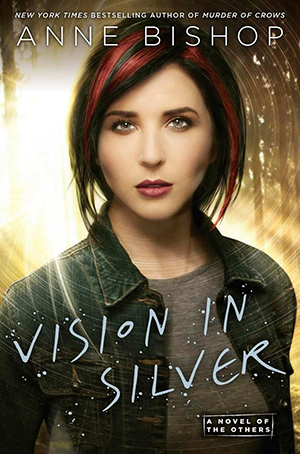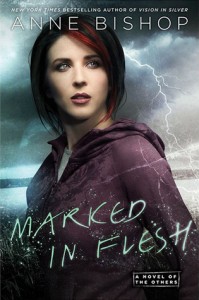 Vision in Silver (The Others, #3) by Anne Bishop
Vision in Silver (The Others, #3) by Anne Bishop Formats available: hardcover, paperback, ebook, audiobook
Series: The Others #3
Pages: 400
Published by Penguin Publishing Group on March 3rd 2015
Purchasing Info: Author's Website, Publisher's Website, Amazon, Barnes & Noble, Kobo, Bookshop.org
Goodreads
The Others freed the cassandra sangue to protect the blood prophets from exploitation, not realizing their actions would have dire consequences. Now the fragile seers are in greater danger than ever before—both from their own weaknesses and from those who seek to control their divinations for wicked purposes. In desperate need of answers, Simon Wolfgard, a shape-shifter leader among the Others, has no choice but to enlist blood prophet Meg Corbyn’s help, regardless of the risks she faces by aiding him.
Meg is still deep in the throes of her addiction to the euphoria she feels when she cuts and speaks prophecy. She knows each slice of her blade tempts death. But Others and humans alike need answers, and her visions may be Simon’s only hope of ending the conflict.
For the shadows of war are deepening across the Atlantik, and the prejudice of a fanatic faction is threatening to bring the battle right to Meg and Simon’s doorstep…
My Review:
I read this in one night. I also read Marked in Flesh all in one night, two nights later. Once I got started, I couldn’t stop. (Cass and I will be posting a joint review of Marked in Flesh next week)
I will say that I was a bit surprised comparing the book to the blurb, at least in one sense. The blurb gives the impression that Meg cuts a lot more often than she does. Not that it doesn’t happen, and that one of the times it happens isn’t traumatic, but she doesn’t cut nearly as often as it sounds, and Simon doesn’t ask her to do it anywhere near as often as it sounds.
It’s not that he doesn’t need her help, because he certainly does. But a part of the help that he needs is for Meg to figure out other ways that the cassandra sangue can let out their prophecies without having to cut. While that solution won’t work for everyone, and it won’t work all the time, and it won’t deal with the built in addiction to the euphoria that comes after cutting and prophesying, it is a start. And a big, big help.
 Written in Red was all about Meg adapting to the wider world. Murder of Crows felt like it was about the world, especially the world of the Others and the Courtyards, adapting to Meg. Vision in Silver takes things a step further. Now that we know that the terra indigine that we see are not the only ones that there are, or even the most powerful Others that there are, the story in Vision in Silver seems to be about the humans lack of adaptation to the Others.
Written in Red was all about Meg adapting to the wider world. Murder of Crows felt like it was about the world, especially the world of the Others and the Courtyards, adapting to Meg. Vision in Silver takes things a step further. Now that we know that the terra indigine that we see are not the only ones that there are, or even the most powerful Others that there are, the story in Vision in Silver seems to be about the humans lack of adaptation to the Others.
The tone of the book reminded me of Katherine Kurtz’ Deryni series again, in that sense of “the humans kill what they do not understand.” In the case of the Others, a better description would be that the humans attempt to kill what they do not understand. And because their understanding is so delusional, and so far off the mark from the reality of what the Others are capable of, it is clear in Vision in Silver that we are heading towards a situation where what the humans don’t understand is going to kill an awful lot of them.
But we’re not quite there yet. In Vision in Silver we see the gathering storm. The humans, misled by the Humans First and Last neo-Nazi organization, believe that they can push the terra indigine back as far into the wild places as the humans want, and that the humans can take over whatever and wherever they please.
And, of course, in typical race-baiting idiocy, Humans First and Last encourages its followers to start by wiping out the non-believers at home, inciting rioting and murder of anyone in the human community who is willing to work with the Others instead of against them.
Everyone in Lakeside who has been cooperating with the Courtyard is targeted. Not only are they pushed out of their homes and jobs, but they are attacked in broad daylight with police looking on and doing nothing.
Obviously not those police officers working with Captain Burke and Lieutenant Montgomery. They understand the consequences of breaking the agreements with the Others, and are actively working with Simon Wolfgard and the Lakeside Courtyard to find another, better way. When life on the outside becomes too hot for them, their families are relocated to the Courtyard for protection. Most Courtyards have a kind of “hands off” attitude to the human population that surrounds them – in Lakeside they are not just letting them inside, they are making them part of the pack.
Meanwhile, Meg and a few of the released cassandra sangue are having visions of the war that is brewing. And because Simon Wolfgard is the only Courtyard leader to form a working relationship with humans, the Elders of the Others come to ask him a question, “How much human should we keep?”
In the midst of increasing tensions and rising death counts, Simon is forced to face the consequence of his actions, the action that brought Meg Corbyn into the Courtyard and seems to be re-shaping the world.
When the Elders strike back at the humans who have gone so horribly wrong, how much human adaptation should survive among the terra indigine? How many humans should survive? How many of his human pack can Simon protect? And how many should he?
 Escape Rating A: I want to say that this is the “things are always darkest just before they turn completely black” book in this series, and that might be about right. Things certainly do get blacker in Marked in Flesh.
Escape Rating A: I want to say that this is the “things are always darkest just before they turn completely black” book in this series, and that might be about right. Things certainly do get blacker in Marked in Flesh.
If you love urban fantasy or alternate history, this series is a winner from beginning to its current stopping point. But it would be impossible to make sense of it by starting in the middle. This is a series where you have to start from the beginning, with Written in Red, so that you can adapt to the world with Meg.
A big part of what makes this series so compelling for readers is the interrelationships. All of the Others are predators, and most of them are apex predators. And yet, all of the Others who have chosen to live in a Courtyard have learned to adapt. Even in those Courtyards where they have not adapted much to the humans around them (and that’s most of them) they have adapted to work with each other. Vlad Sanguinati and Simon Wolfgard would normally range far from each other. Instead, the vampire and the wolf-shifter are friends, and it’s a relationship that surprises them both.
As Meg “grows up” we see more of her vulnerabilities. She’s less perfect than she was. The more she learns, the more doubts she has. And at the same time, she is still very much loved and protected. But the universal love that surrounds her seems less Mary-Sue-ish now that her gifts are being explored. Especially as we learn that all of the Others have an extreme reverence for her gift, as well as a healthy fear of it. While the too-frequent references to Meg and the cassandra sangue’s status as “Namid’s gift, wondrous and terrible” get repetitious, they do reinforce the point that part of the reason Meg is treated the way she is is out of both respect for her gift and fear of it – her blood is too easily shed, and poisonous to the terra indigine.
Another reviewer described Simon and Meg as adorkable, and that’s about right. They are moving very, very tentatively towards being more than friends, but neither of them has the remotest clue what that might mean. Nor do either of them seem emotionally prepared for the possibility. But like so many relationships in real life, it’s happening anyway. And it’s lovely and silly and cute to watch. Even though some of the overtones that Cass and I will discuss in our review of Marked in Flesh do give me pause.
I would say that one of the things that keeps surprising me is just how damn stupid the general human population is in this series. Then I read the morning news and am forced to remember that humans are just that stupid and easily (mis)led in real life, too.
